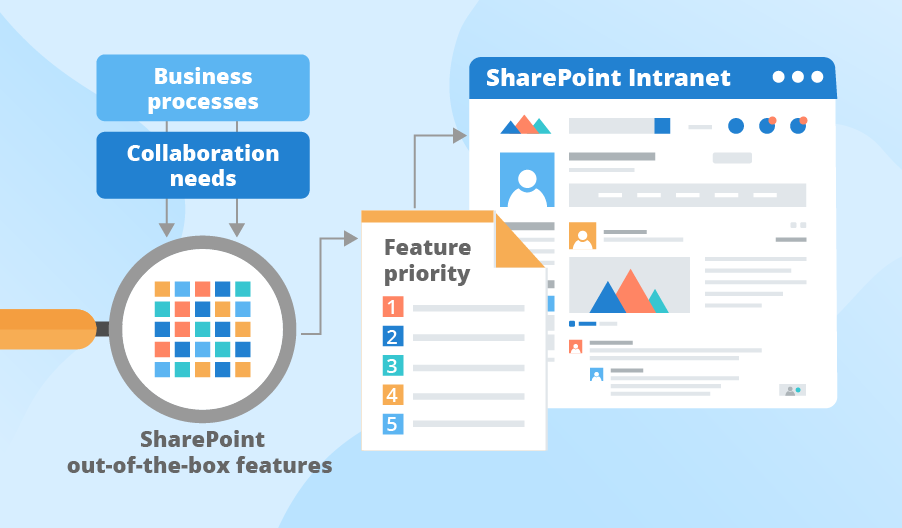Prioritizing SharePoint intranet features: What it means for the success of your solution
Air Canada, the largest Canadian airline, relies on their SharePoint-based intranet called ACaeronet to automate internal processes. Booz Allen Hamilton, a large US consulting firm, chose SharePoint Online to create collaborative digital workspaces for their employees. Coles, a major food retailer in Australia, implemented their intranet to encourage idea exchanges and innovation thinking in order to improve customer experience.
These examples prove how differently companies see their SharePoint intranets and how various are the goals they want to achieve with an intranet. Obviously, all the companies above have put substantial effort into tailoring their intranets to make them answer their purposes. But what were the most important things on their way to an effective SharePoint intranet?

Don’t get lost in the out-of-the-box
By deploying an out-of-the-box SharePoint intranet you don’t get a ready-to-go solution, but rather a feature kit. Feature diversity is among the biggest SharePoint intranet advantages, but it can become a trap too. Enabling all the available out-of-the-box features won’t guarantee a successful solution. On the contrary, this can end up with a confusing intranet that offers everything but solves nothing.
To avoid that, you have to prioritize SharePoint features in the very beginning of your project. It means, you should define what particular features from the entire out-of-the-box set you’ll develop and customize to cover your business needs. To make the right decision, you should analyze at least two things:
Organizational processes. First of all, determine what processes you want to automate or support and find out if and how you can achieve that with SharePoint. For example, if you want to improve your supply department’s performance, it’s worth thinking about advanced workflow management features. And if the number of projects in your company has risen substantially, but you still don’t have a tool to manage them, it means you should prioritize the project management features.
Corporate collaboration patterns. Second, you should define how collaboration rolls in your company. If employees work within a strict hierarchy and their interaction is mostly document-based, think about the document management features. At the same time, if team collaboration boils and employees have only a corporate chat at their disposal, consider delivering powerful team sites.
Stay feature-focused to ensure long-term positive outcomes
Choosing the key functionality of your SharePoint intranet will enable you to move on with other important decisions that will determine the success of your solution.
Define the scope of your project. Once you’ve selected the core functionality to tailor, you’ll see the scope of your initial customization project, which will allow you to plan your budget accordingly. This will also prevent you from diving into an endless project, and you’ll get the most important features ready to use just a few months after the SharePoint deployment.
Foresee effort and cost of development and support. If you determine the scope of your SharePoint intranet customization, you’ll understand how much you should invest in the intranet development and what support effort it will require. These calculations are critical if you don’t have an in-house SharePoint team and get SharePoint services from a vendor.
Prevent intranet rejection. If you implement intranet features that facilitate employees’ daily activities, your intranet will be well-adopted and used actively. Moreover, it’s always worth staying user-centric. Thus, if your company is full of enthusiastic and lively people, they’ll hardly appreciate a formal intranet, but they’ll be happy to see social features able to support their informal collaboration.
Involve users to create an effective SharePoint intranet
To succeed with your SharePoint intranet, it’s important to involve users at different stages of the project. Although it’s always easier to delegate the entire development work to your SharePoint team, user-centric development works much better for SharePoint.
Cooperating with end users, SharePoint developers can sift out unnecessary features much faster. Users can also share their preferences on the SharePoint intranet structure, design, page layouts and device compatibility.
It’s also reasonable to form focus groups that will try out customized intranet features. This is a feasible measure to minimize the risk of the future solution rejection. Optimally, end users should test each particular solution included into their intranet. Thus, if you tailor a team site template, invite representatives from different teams to check it up before making it generally available.
Finally, organize training sessions to show employees how to use their SharePoint intranet efficiently. Later on, when users will get used to their intranet, training sessions can be replaced with monthly meetups. During these meetups, users will be able to express their feedback, voice concerns and challenges, which will allow the development team to fix the revealed issues timely.
Improve the core of your SharePoint intranet continuously
Even after the desired intranet functionality has been implemented, it’s not the time to get relaxed. It happens quite often that after several months or years of active use, employees start to dislike previously popular solution, as particular features become irrelevant for users or insufficient to cover their needs. That’s why you should constantly adapt existing intranet features to new users’ requirements.
For example, if employees stick to knowledge management, focus on tweaking content management features, search capabilities and make sure the knowledge base isn’t overloaded. If your intranet is the heart of employees’ social life, bring new entertaining features regularly, support community sites, refresh their design or add custom web parts. To get a better idea of an effective SharePoint intranet, you are welcome to check our interactive demo.
Summing it up
If you choose SharePoint as your intranet platform, you get a lot of opportunities, but you will also have to address several challenges. Prioritizing intranet features is one of these challenges that determines the future success of the solution, your investments and development effort, as well as positive adoption of the intranet among employees.
To make a right decision, analyze your business processes and collaboration needs and clear up how SharePoint can cover them. What’s more, avoid delegating the intranet implementation to your IT department only, involve employees to follow their preferences and create a solution that does help them perform better and spend less effort on daily tasks.


